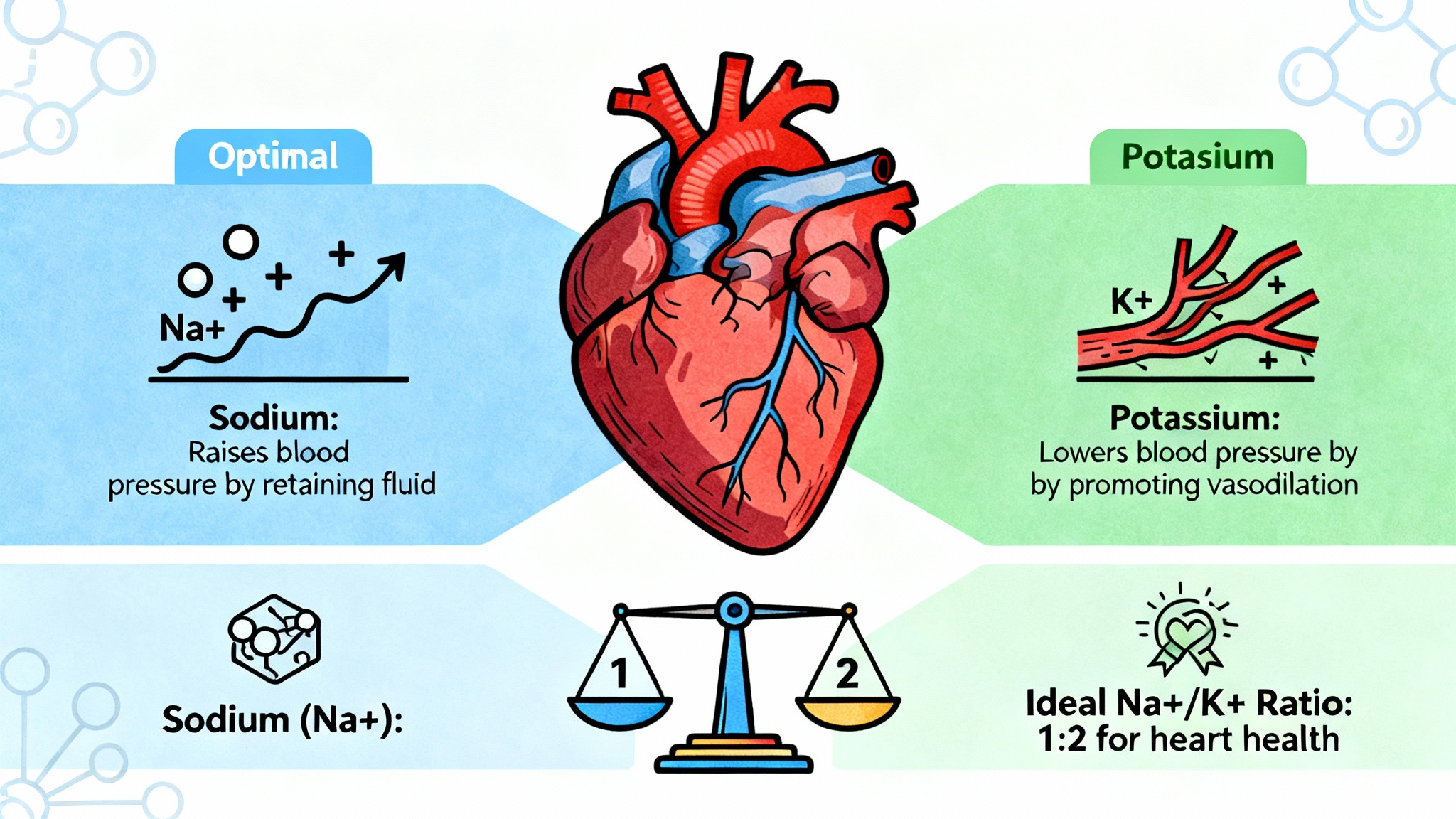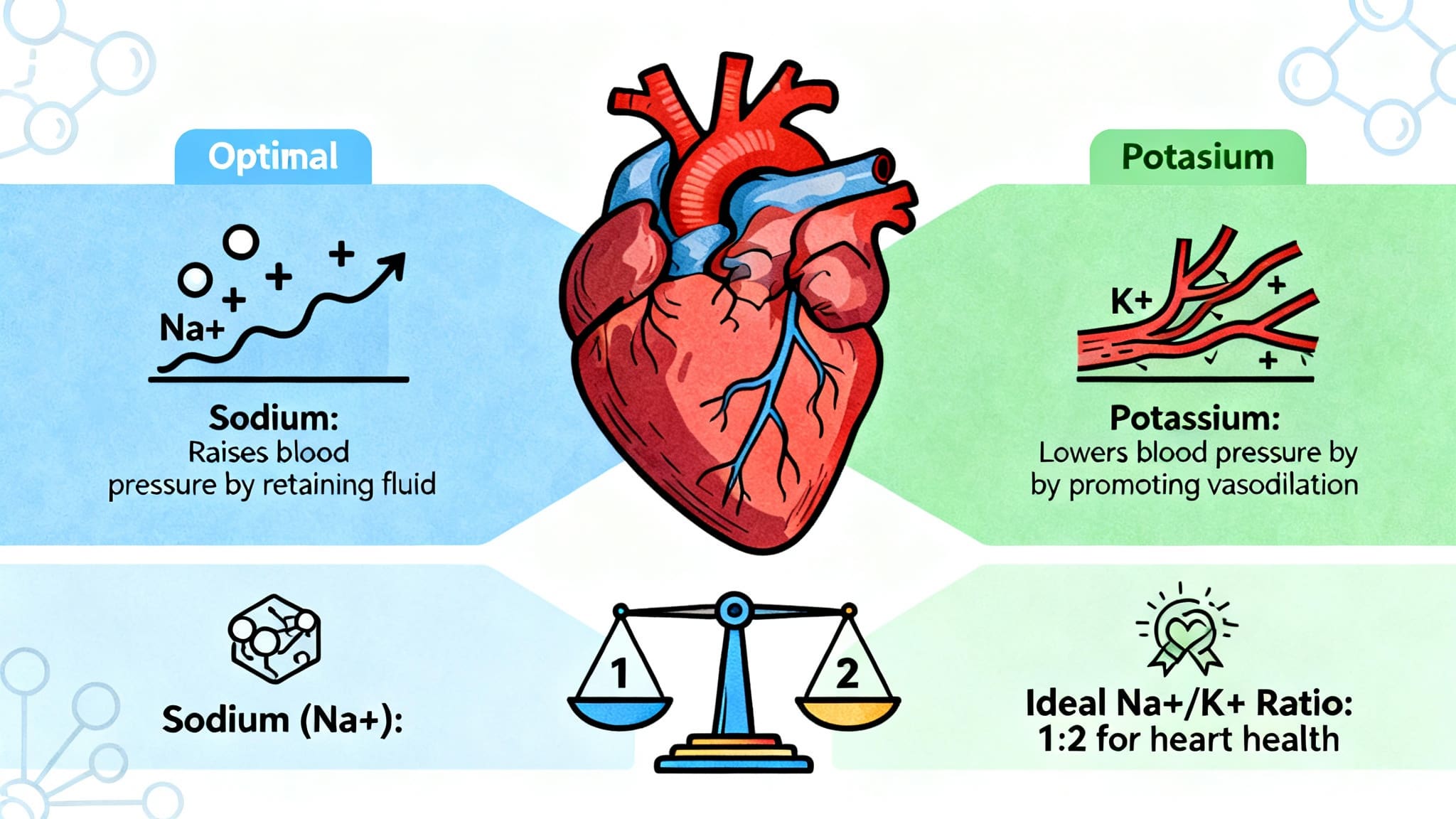Introduction
Effective management of electrolytes, such as sodium and potassium, is crucial for heart health and achieving an optimal heart. These essential minerals play a foundational role in regulating blood pressure—a major factor in heart disease prevention and cardiovascular outcomes. Understanding the interaction between sodium sensitivity, potassium-rich foods, and the sodium-potassium ratio not only helps you support your heart health, but it also empowers you to manage hypertension more effectively. This article delves into the practical and scientific aspects of maintaining an optimal mineral balance for an optimal heart.
What is Clarify Sodium Sensitivity, Potassium‑Rich Foods, and the Sodium‑Potassium Ratio for Blood Pressure Control?
Sodium sensitivity refers to the body’s specific response to sodium intake; some individuals experience notable changes in blood pressure when consuming too much sodium, while others are less affected. Potassium-rich foods—including leafy greens, beans, and bananas—help counterbalance the negative effects of high sodium, playing a vital biological role in cardiovascular health. The sodium-potassium ratio (the amount of sodium consumed relative to potassium) is recognized as a stronger predictor of heart health than sodium intake alone. Maintaining this optimal balance is strongly associated with lower blood pressure, improved arterial function, and reduced risk of cardiovascular events [Whelton et al., 2022][Mente et al., 2018].
Benefits and Outcomes in Heart Disease
Numerous studies link excessive sodium intake to increased blood pressure levels, which directly impact heart health and increase the risk of stroke and heart attack [Appel et al., 2011]. Conversely, potassium-rich diets are associated with lower blood pressure, reduced arterial stiffness, and improved overall cardiovascular outcomes [Aburto et al., 2013]. Optimizing the sodium-potassium ratio is particularly effective in supporting an optimal heart—more so than targeting sodium reduction alone [Yang et al., 2011]. Furthermore, balanced mineral intake has been shown to reduce arterial plaque, lower bad cholesterol, decrease the likelihood of blood clots, and control systemic inflammation, all critical for long-term heart health [Lennon et al., 2021].

Research Insights
Recent clinical trials highlight the importance of both lowering dietary sodium and increasing potassium intake for optimal heart health. For example, the 2018 PURE study found that communities with higher potassium intake and lower sodium, or more favorable sodium-potassium ratios, had significantly fewer cardiovascular events and lower all-cause mortality [Mente et al., 2018]. A 2022 American Heart Association report strongly recommends focusing on increasing potassium as much as reducing sodium [Whelton et al., 2022]. Meta-analyses also confirm that dietary potassium can counteract the blood-pressure-raising effects of sodium, especially in sodium-sensitive populations [Aburto et al., 2013]. These findings underscore the importance of a holistic approach to electrolyte balance for supporting an optimal heart.
Practical Applications
Supporting heart health through electrolyte management is accessible and actionable. Opt for potassium-rich foods like spinach, sweet potatoes, avocados, and legumes while minimizing processed, high-sodium foods. Ideally, adults should keep sodium intake below 2,300 mg per day and aim for at least 3,500 mg of potassium, based on guidelines [U.S. Department of Health & Human Services, 2020]. Sodium sensitivity is more pronounced in older adults, those with hypertension, or a family history of heart disease, making adherence particularly crucial for these groups [Whelton et al., 2022]. While supplements are available, consuming nutrients through whole foods is preferable for an optimal heart.
Risks & Limitations
Despite clear benefits, extremely low sodium or excessive potassium can be harmful, particularly in those with kidney disorders or on specific medications [Lennon et al., 2021]. Research also indicates individual variability—what works for one person may not suit another, particularly regarding sodium sensitivity. Current research is evolving, and while guidelines are broadly applicable, personalized dietary advice from a healthcare provider is best for achieving heart health and an optimal heart [Whelton et al., 2022].
Key Takeaways
- Managing sodium and potassium intake is essential for heart health and achieving an optimal heart.
- Sodium sensitivity varies; those affected benefit most from lowered sodium and increased potassium.
- The sodium-potassium ratio is a better indicator of heart disease risk than sodium alone.
- Potassium-rich diets help lower blood pressure, reduce inflammation, and improve cardiovascular outcomes.
- Adhering to recommended intake levels supports both prevention and management of hypertension.
Frequently Asked Questions
Q1: Why is sodium-potassium balance important for heart health?
Balancing sodium and potassium helps regulate blood pressure and supports an optimal heart, reducing heart disease risk [Whelton et al., 2022].
Q2: What foods are highest in potassium for optimal heart health?
Potassium-rich foods include leafy greens, beans, avocados, bananas, and sweet potatoes [U.S. Department of Health & Human Services, 2020].
Q3: How can I tell if I am sodium sensitive?
Sodium sensitivity is more common in older adults, those with high blood pressure, and people with certain medical conditions. A doctor can help determine your sensitivity level [Mente et al., 2018].
Q4: Can I take potassium supplements instead of eating potassium-rich foods?
It’s best to get potassium from foods rather than supplements, unless your doctor recommends otherwise, to support optimal heart health [Aburto et al., 2013].
Q5: What’s a simple way to improve my sodium-potassium ratio?
Eat more fruits and vegetables, and cut back on processed foods high in sodium [Yang et al., 2011].
Suggested Links
- American Heart Association – Sodium and Potassium
- NIH – Dietary Sodium and Potassium
- PubMed – Blood Pressure and Electrolytes
Conclusion
Balancing sodium and potassium is critical for heart health and optimizing cardiovascular outcomes. By understanding your sodium sensitivity and emphasizing potassium-rich foods, you can achieve an optimal heart and reduce your risk of hypertension and heart disease. Integrating these changes doesn’t have to be overwhelming—focus on gradual dietary shifts and consult a healthcare professional for personalized advice. Begin today and take actionable steps for lifelong heart health and an optimal heart.



